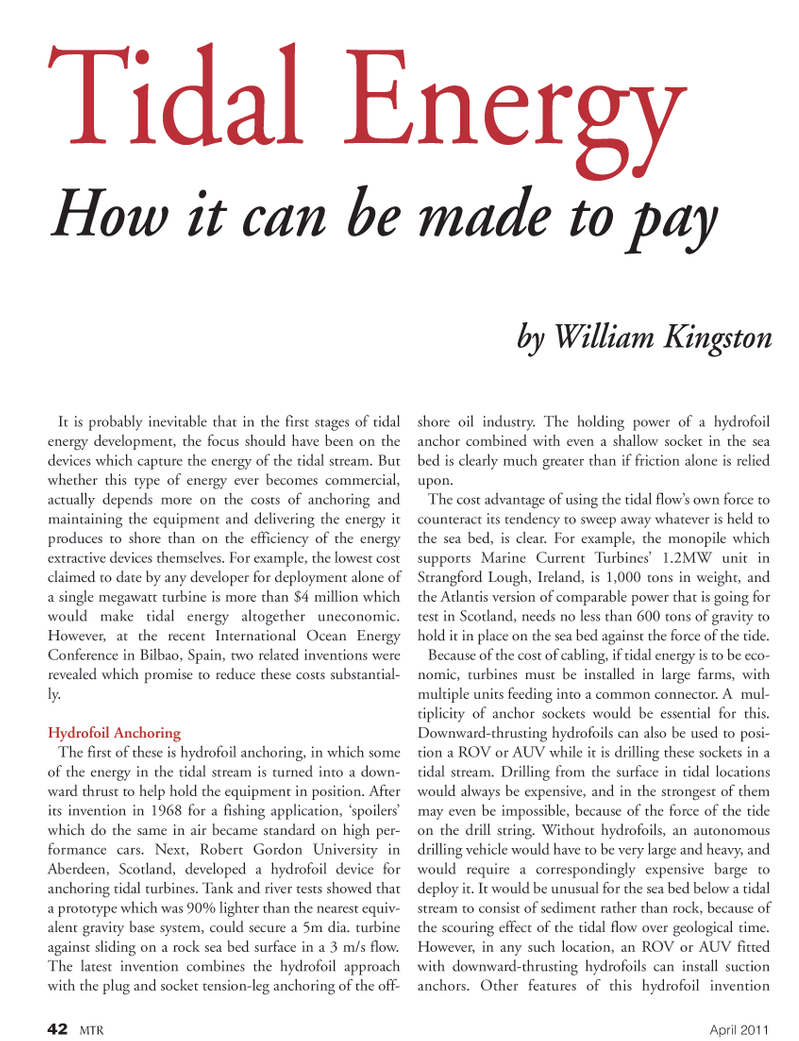
Page 42: of Marine Technology Magazine (April 2011)
Oil & Gas SubSea Monitoring
Read this page in Pdf, Flash or Html5 edition of April 2011 Marine Technology Magazine
It is probably inevitable that in the first stages of tidal energy development, the focus should have been on the devices which capture the energy of the tidal stream. But whether this type of energy ever becomes commercial, actually depends more on the costs of anchoring and maintaining the equipment and delivering the energy it produces to shore than on the efficiency of the energy extractive devices themselves. For example, the lowest cost claimed to date by any developer for deployment alone of a single megawatt turbine is more than $4 million which would make tidal energy altogether uneconomic.
However, at the recent International Ocean Energy
Conference in Bilbao, Spain, two related inventions were revealed which promise to reduce these costs substantial- ly.
Hydrofoil Anchoring
The first of these is hydrofoil anchoring, in which some of the energy in the tidal stream is turned into a down- ward thrust to help hold the equipment in position. After its invention in 1968 for a fishing application, ‘spoilers’ which do the same in air became standard on high per- formance cars. Next, Robert Gordon University in
Aberdeen, Scotland, developed a hydrofoil device for anchoring tidal turbines. Tank and river tests showed that a prototype which was 90% lighter than the nearest equiv- alent gravity base system, could secure a 5m dia. turbine against sliding on a rock sea bed surface in a 3 m/s flow.
The latest invention combines the hydrofoil approach with the plug and socket tension-leg anchoring of the off- shore oil industry. The holding power of a hydrofoil anchor combined with even a shallow socket in the sea bed is clearly much greater than if friction alone is relied upon.
The cost advantage of using the tidal flow’s own force to counteract its tendency to sweep away whatever is held to the sea bed, is clear. For example, the monopile which supports Marine Current Turbines’ 1.2MW unit in
Strangford Lough, Ireland, is 1,000 tons in weight, and the Atlantis version of comparable power that is going for test in Scotland, needs no less than 600 tons of gravity to hold it in place on the sea bed against the force of the tide.
Because of the cost of cabling, if tidal energy is to be eco- nomic, turbines must be installed in large farms, with multiple units feeding into a common connector. A mul- tiplicity of anchor sockets would be essential for this.
Downward-thrusting hydrofoils can also be used to posi- tion a ROV or AUV while it is drilling these sockets in a tidal stream. Drilling from the surface in tidal locations would always be expensive, and in the strongest of them may even be impossible, because of the force of the tide on the drill string. Without hydrofoils, an autonomous drilling vehicle would have to be very large and heavy, and would require a correspondingly expensive barge to deploy it. It would be unusual for the sea bed below a tidal stream to consist of sediment rather than rock, because of the scouring effect of the tidal flow over geological time.
However, in any such location, an ROV or AUV fitted with downward-thrusting hydrofoils can install suction anchors. Other features of this hydrofoil invention 42 MTR Jan April 2011
Tidal Energy
How it can be made to pay by William Kingston

 41
41

 43
43
